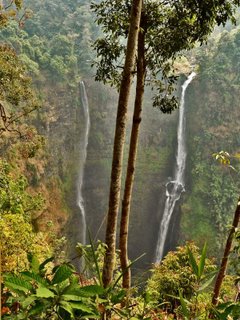 A rather spooky town, Vieng Xai is the living time capsule of a grandiose moment in Lao history: the victorious culmination of a three-decade Communist insurgency that cut the country from 200 years of Thai and French colonialism.
A rather spooky town, Vieng Xai is the living time capsule of a grandiose moment in Lao history: the victorious culmination of a three-decade Communist insurgency that cut the country from 200 years of Thai and French colonialism.It is also, by any stretch, a ghost town worthy of the Twilight Zone crumbling with vestiges of jingoism and failed pretensions to Soviet grandeur. A very spooky town.
The town's central monument - a prematurely ageing cement statue of a rifle-toting female farmer, a soldier and a worker whose foot rests triumphantly on a bomb marked "USA" - has the flimsy amateur feel of a backdrop in a school play.
Never has a lesser word been said in jest. God bless America.
Weeds and piles of rubbish overrun the courtyard in the boarded-up cultural centre, while the giant circular Party emblem mounted above the centre's entrance is flaking apart, its faded Lao flag barely recognisable and the star on its wreath dangling by a nail.
It's hard to imagine how this loop of streets once merited the distinction "City of Victory", or even just "city", much less that leaders of the Lao revolution envisaged it would become a remote cultural oasis and symbolic cradle of Marxism in Laos.
Of course, these were men who barely saw a full day's sunlight in more than a decade. Then again, maybe this is an apt symbol.
Lying at the base of a limestone mountain range between Xam Neua and the Lao-Vietnamese border at Nam Meo, it was from Vieng Xai that the Lao Communist Party (the Pathet Lao) waged its "30-year struggle" against a succession of coalition governments and US-backed Royal Lao forces that ended in 1975.
For ten years starting in 1963, when relentless US air strikes began showering northern Laos with cluster bombs, Pathet Lao leaders lived in an extensive network of limestone caves, effectively operating a shadow government from a hidden city.
Though farmers spent the war years in and out of the hundreds of caves speckling the town's environs, only five caves make up the official tour of Vieng Xai. Well-preserved, if a bit spartan, the quintet served as the headquarters for the masterminds of the Pathet Lao.
Arrival and after
Tuk tuks generally depart the Sam Neua bus station every half an hour from early morning until about 15:00 or 16:00. The journey costs 7,000 kip per person, and takes about an hour. No guide no hidden city. No money no guide.
Sleep
The modest Vieng Xai hotel: an almost crestfallen guesthouse once in the day built to billet foreign luminaries, though the exiled Lao royal family and their re-education camp-bound followers may have been the Vieng Xai's best customers.
Now looking more like a hospital than a four-star hotel, rooms go for $2-3 and can come with breath-taking views of the limestone mountains and the cluster of Hmong houses next door.

No comments:
Post a Comment